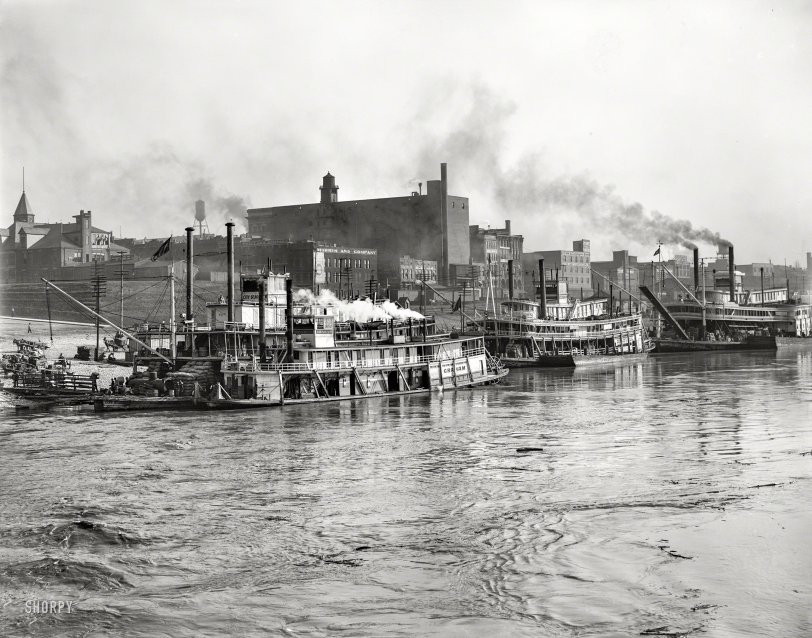


Framed or unframed, desk size to sofa size, printed by us in Arizona and Alabama since 2007. Explore now.
Shorpy is funded by you. Patreon contributors get an ad-free experience.
Learn more.

- Baldwin 62303
- Baldwin VO-1000
- Cold
- No expense spared
- Tough Guys
- Lost in Toyland
- And without gloves
- If I were a blindfolded time traveler
- Smoke Consumer Also Cooks
- Oh that stove!
- Possibly still there?
- What?!?
- $100 Reward
- Freeze Frame
- Texas Flyer wanted
- Just a Year Too Soon
- WWII -- Replacing men with women at the railroad crossing.
- Yes, Icing
- You kids drive me nuts!
- NOT An Easy Job
- I wonder
- Just add window boxes
- Icing Platform?
- Indiana Harbor Belt abides
- Freezing haze
- Corrections (for those who care)
- C&NW at Nelson
- Fallen Flags
- A dangerous job made worse
- Water Stop
Print Emporium
The Levee: 1908

The sternwheelers Graham, Harry Lee and James Lee.
Memphis, Tennessee, circa 1908. "Mississippi River levee from the ferry." 8x10 inch dry plate glass negative, Detroit Publishing Company. View full size.
The Boiler
It's called a "Brickset HRT (Horizontal Return Tube)". When it's delivered to the customer local masons and boiler mechanics will build a box-type firebrick structure which the boiler will be mounted on. It can burn practically anything that's combustible. There are still some of these old HRTs in operation today. They've all been converted from coal to oil, then to natural gas over the years, but still doing what they were built to do, many years ago.
Ed B.
Now (s)hear this
Western river steamboats were designed with light, flexible hulls for the conditions of the waters in which they worked. Most had no true keel, a flat bottom, and small bracing between the ribs. The hogchains, which ran from fore to aft and braced in the center, pushed down on the mid-ship braces and pulled the bow and stern up. This layout gave the hulls flexibility to ride over shoals and sandbars, but the strength to carry heavy loads. Most boats drew less than six feet of water, some as little as 18 inches.
It's a boiler, all right, but not for a locomotive
That's most likely a stationary boiler for a sawmill or other factory. It will be placed on a brick "setting."
Though it does have fire tubes and a steam dome, but it lacks the double-wall firebox of a locomotive boiler. Said firebox would be on the near end, as the steam dome is on the near end.
It's not all that likely to be a marine boiler, either. Again, it has no built-in firebox.
Stationary boiler, not a locomotive
The cylindrical object on the foredeck of the City of St Joseph is almost certainly the boiler of a stationary power plant, which would have supplied steam to an accompanying single-cylinder engine. Such semi-portable "packaged power" was in common use in the absence of internal combustion or electricity from grids, in such industrial processes as sawing wood, pumping water, generating electricity for local use, or driving milling machinery. All you need to run them was firewood (or coal) and water. Several firms produced these sets in kit form and shipped them round the country. The crates and tarpaulined cargo next to the boiler probably consist of the rest of the set-up.

Low Rider
The Graham has about one foot of distance between the deck and the river in the middle of the boat. Waves from other boats or barges could breach the deck if passing too close.
Shear Delight
The amount of shear (the curvature of the decking from bow to stern, as opposed to flat so common now) in the design of those vessels is astonishing. I've never understood the value of shear myself in shipbuilding, but some liner buffs have distaste for vessels with none, though even some of the largest liners like Normandie of 1935 were designed with nearly none. These vessels positively look like swayback mules. I'd be interested in others' perspectives on why such shear was built into them.
Missed One
The steamer City of St. Joseph, starboard side of the Graham. Never saw a steamer as swaybacked as the Henry Lee.
Re: Still No Channel
The depth of the river at Memphis even at this date was 20 to 50 feet. If this photo was taken from a ferry, I'd bet that turbulence is from wheel wash and wake.
Boiler
Is that a boiler for a Locomotive on the front of the boat?
Steam Train Parts?
Is that a train steamer part on the front deck? Also, very low in the water. Sure, no waves on the Old Miss, but still...
Also includes The City of St Joseph
Later renamed Eclipse
Name:ECLIPSE, originally the CITY of ST. JOSEPH
Type: Stern-wheel, wooden hull packet. Size:
Launched: 1903
Destroyed: 1925, Sept. 12, opposite Oceola, Ark. Snagged.
Still No Channel
Judging by the ripple and swirl of the water, this section of the river has yet to be dredged to allow safer barge passage. The captains of these vessels were still river pilots in the true sense, always on alert for shoals, submerged tree trunks, etc. Every river in the Mississippi drainage that handles barge traffic has been channelized by now.
























On Shorpy:
Today’s Top 5